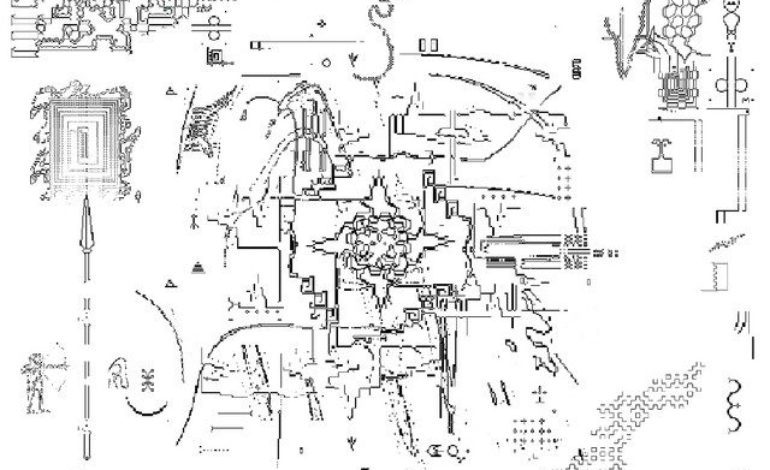

Ambient electronic producer puts together his most alien, abrasive and experimental release to date
Nicolás Jaar is a technical mastermind. Throughout his young career, he’s displayed time and time again the ability to craft meticulously intricate beats and sounds. Jaar’s distinctive brand of house and electronic music has garnered him critical acclaim around the world. But Jaar’s third and most recent project of 2020, Telas, would be recommended by 10 out of 10 extraterrestrials. It’s a sonic Jackson Pollock painting, alien and surreal in its ambience, as Jaar puts forth his most experimental work to date.
Telas is composed of just four songs, though each runs approximately 15 minutes. Across those four tracks, Jaar coaxes out simultaneously futuristic and ancient sounds, placing wonky effects on rudimentary sounds like clangs, bangs and thumps to make them sound otherworldly. There are many adverse ideas at play, with Jaar shifting fluidly between conflicting moods and sounds across each track.
Opening track “Telahora” is disorienting from the start, with distorted brass and reeded instruments chaotically layered on top of each other. The percussion is jangly and frantic, and the entire ensemble sounds like a mess of sound. Around two minutes in, this chaos is replaced by shimmering, reverberating synthesizers and a cutting bass. Jaar builds the instrumental from the bottom up, swirling and spinning the synths around the bass like a merry go round.
The track’s next shift comes about six minutes in with popping and skittering percussion that resembles bubbling. Jaar adds in muted synths and spliced, echoey guitars for color, as well as what seem to be sounds created using the room around him. Lo-fi scrapes, bangs and knocks are prominent in the mix, and Jaar scores points for resourcefulness. The track’s final change is at the 10 minute mark, as dissonant bells ring in the songs’s outro. Jaar fills out this section with abrasive and glitched out squeaking, booming, bubbling, flapping and whispering, while a heavily distorted triangle creates a loose beat to move things forward.
The track “Telencima” opens with perhaps the most alien passage of the record with wildly distorted synths that have the effect of rising or falling. Hornlike synths create a base around which Jaar layers wobbly synthesizers, sudden ambient noises and computerized beeps. He contrasts this with perhaps the sweetest section of the album. At around the five minute mark, layered and cascading beeps and tones create a waterfall effect. He adds in a harplike synth at the bottom of the mix, and the beeps and tones begin to shimmer and shine as the mix progresses, creating a feeling of fluidity.
The track’s next section is buoyed by detuned, shimmering synths that soar over the mix, but some ear-numbingly harsh and spliced synthesizers soon enter and signal the dissolution of the instrumental. The synths begin playing jumbled notes while the mix fades out.
“Telahumo” opens with what feels like a satellite transmission being interrupted with its jarring, static instrumentation, before Jaar opens the mix up more, pairing choral vocals with echoey percussion that conjures up images of a cathedral. Later on in the track, he morphs what sounds like microphone feedback into its own instrument, using it to create chords, riffs and arpeggiations. He then impressively layers vibrating bells, ambient rumbling, guitar and vocal snippets onto the mix as it builds and swells. The track’s denouement feels like the fallout from this climax. Muted synths play dissonant chords, reeds and horns repeat an ascending riff and rippling synthesizers add color. The mix here is perfectly balanced, with effective tension and release from the chord progression.
Album closer “Telallás” is the only track with a coherent instrumental throughout. Jaar first uses bongos, skittering beeps and vinyl crackling to make up the percussion, adding in xylophone hits that have their reverberations reversed to create a gliding effect. Muted bells, spliced triangle hits and a keyboard accompaniment enter later, followed by crunchy percussion, ambient skittering and what sound like drops of water hitting the floor of a cavern. As a whole, the song is both glitchy and meditative, with plenty of wonky and sudden sounds but a coherent, dynamic instrumental.
Telas is about as alien-sounding a record as there is. Nicolás Jaar deserves plaudits for the creativity and meticulousness that went into crafting the project, and he conjures up some truly singular sounds. But at the same time, the album is chaotic and abrasive. On each of the first three tracks, Jaar jumps between vastly disparate musical ideas without any clear connection, and the record often sounds jumbled and incoherent. Jaar takes plenty of risks on Telas, and while his experimentations occasionally lead to truly stunning and foreign passages, he’s created a project that’s ultimately difficult to listen to without a headache or a head scratch.
